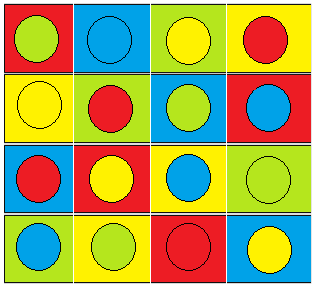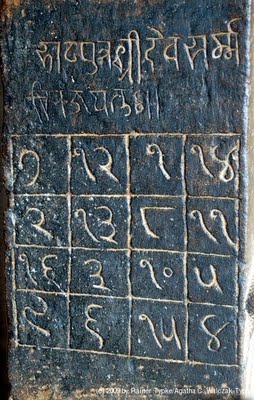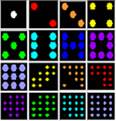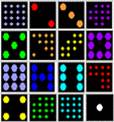Armahedi Mahzar (c) 2016
In my last blog I presented a new kind of magic square built up from monominoes each containing 1 to 16 dots. In this blog I will present you another form of magic square containing varinoes magic as its elements. A varino is a single dot monomino with the the color of the dot and the the color of the background are varied. What are the puzzles around varinoes ?
Varino Magic Squares
If we have 4x4 square, can we distribute all possible 4-colors varinoes such that the dot colors and its background colors are not repeated in the same row, column and diagonal?The following is one of the possible solutions:

Well, since every row column and diagonal has 4 different colored square and 4 different colored dots, they have the same set colored squares and the same set of colored dots, we will called the set pair as the magic set pair.
So, we have generalized the numeric magic square to a general magic square by replacing number with any similarly type element, and replacing the numeric addition with the set union. In this case the elements is the varinos.
Relation to Numeric Magic Square
In fact, the varino magic square is equivalent to numeric magic square, as it will be seen if we proceed the following replacement procedure:
If we replace
• the red square by the numeral ‘0’ and the red dot by the numeral ‘0’
• the blue square by the numeral ‘1’ and the blue dot by the numeral ‘1’
• the green square by the numeral ‘2’and the green dot by the numeral ‘2’
• the yellow square by numeral ‘3’ and the yellow dot by the numeral ‘3’.
then we get the following numerical magic square
| 02 | 11 | 23 | 30 |
| 33 | 20 | 12 | 01 |
| 10 | 03 | 31 | 22 |
| 21 | 32 | 00 | 13 |
with the magic number 66 as the sum of all four numbers in any row, column and diagonal.
This numerical magic square can be transformed to the following numerical magic square
2 5 11 12
15 8 6 1
4 3 13 10
9 14 0 7
with magic number 30, if we read the previous square as quaternary number base 4.
If we add 1 to every number in the last magic square, then we get the ordinary magic square of order 4
3 6 12 13
16 9 7 2
5 4 14 11
10 15 1 8
which isomorphic to the monominoes in the last blog

Afternote
In the next blog we will replace the varinoes with the combinoes which symbolize subsets of a set to get the combino magic square. This is another generalized magic square. Hopefully you will enjoy it as a mathematical recreation.





